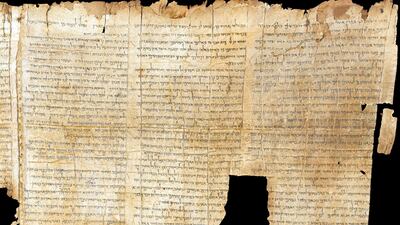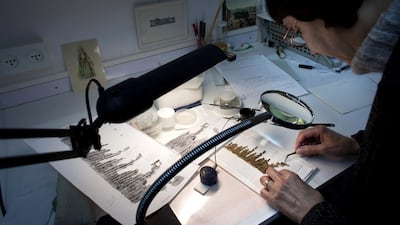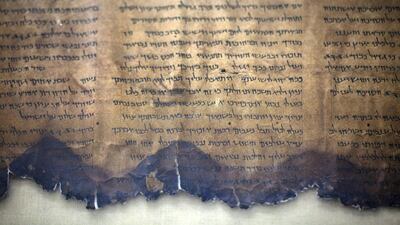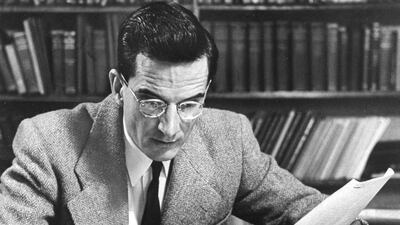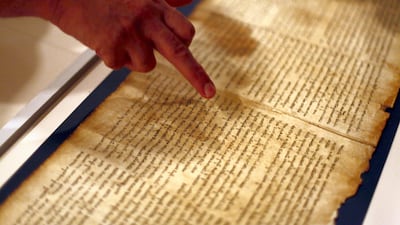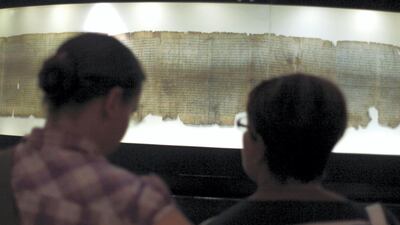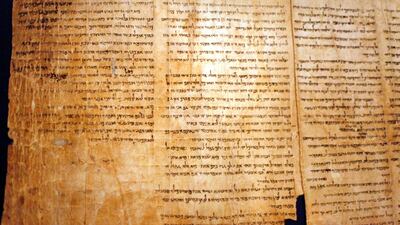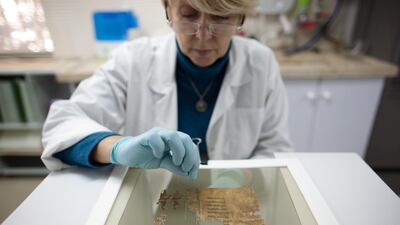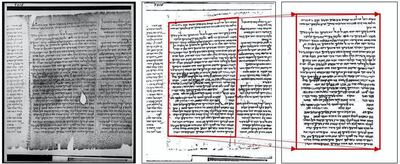Researchers studying the Dead Sea Scrolls say they have shone some light on the mysterious scribes who created the ancient texts by analysing their handwriting.
Discovered in Israel seven decades ago, the Scrolls date back about 2,000 years and contain the oldest manuscripts of the Old Testament and previously unknown Jewish scripture, written in Hebrew and Aramaic.
While their historical importance cannot be contested, little is known about the anonymous scribes who created them.
However, by analysing their handwriting using artificial intelligence, researchers from the University of Groningen in the Netherlands say they can now "shake hands" with the scribes.
The experts say they have proof that at least one of the texts was written by two different people, despite near-uniform penmanship.
The project was spearheaded by University of Groningen professors Mladen Popovic and Lambert Schomaker.
Their research attempted to find a "smoking gun" in the handwriting, such as a specific trait in a letter, to identify a scribe.
Artificial intelligence expert Prof Schomaker has long worked on techniques to allow computers to read handwriting from historical materials.
Using a deep learning algorithm, the academics focused on the famous Great Isaiah Scroll, which was found in Qumran Cave 1.
They closely analysed one character – 5,000 handwritten "a" letters – in a task virtually impossible to the human eye.
First, they trained a computer to separate the text from its background. Then they created "heat maps" of the letter to show minute differences in how it was written.
Due to the differences, the results seemed to confirm that at least two writers created the texts. The similar writing styles suggested a common training or origin.
Researchers say the pioneering research is a totally new way to analyse the scroll texts based on physical characteristics. They hope they can now observe on a "micro-level" how individual scribes and their communities worked on the Great Isaiah texts.
"This is very exciting, because this opens a new window on the ancient world that can reveal much more intricate connections between the scribes who produced the scrolls," Prof Popovic said.
"We are now able to identify different scribes," he said. "We will never know their names. But after 70 years of study, this feels as if we can finally shake hands with them through their handwriting."
While you're here
%20Ramez%20Gab%20Min%20El%20Akher
While you're here
Gavin Esler: Will 2021 be Boris Johnson's worst year?
Thomas Harding: US relations with Europe could change
Brodie Owen: How England’s new lockdown rules work
Whiile you're here
Damien McElroy: Anti-science attitudes in America are proving lethal
Editorial: What makes the UAE such a good place to test vaccines?
Editorial: The fight against Covid-19 should be guided by science
The%20specs%3A%202024%20Mercedes%20E200
Dubai Bling season three
Cast: Loujain Adada, Zeina Khoury, Farhana Bodi, Ebraheem Al Samadi, Mona Kattan, and couples Safa & Fahad Siddiqui and DJ Bliss & Danya Mohammed
Rating: 1/5
While you're here
While you're here
Damien McElroy: It's too early to say who will win the vaccine hurdle race
Mustafa Alrawi: To get the 'jab' done, governments must show patience and empathy
Editorial: The fight against Covid-19 should be guided by science
While you're here
Hussein Ibish: There are reasons for Democrats and Republicans to be happy
Rashmee Roshan Lall: Who are the women driving Joe Biden's success?
Some of Darwish's last words
"They see their tomorrows slipping out of their reach. And though it seems to them that everything outside this reality is heaven, yet they do not want to go to that heaven. They stay, because they are afflicted with hope." - Mahmoud Darwish, to attendees of the Palestine Festival of Literature, 2008
His life in brief: Born in a village near Galilee, he lived in exile for most of his life and started writing poetry after high school. He was arrested several times by Israel for what were deemed to be inciteful poems. Most of his work focused on the love and yearning for his homeland, and he was regarded the Palestinian poet of resistance. Over the course of his life, he published more than 30 poetry collections and books of prose, with his work translated into more than 20 languages. Many of his poems were set to music by Arab composers, most significantly Marcel Khalife. Darwish died on August 9, 2008 after undergoing heart surgery in the United States. He was later buried in Ramallah where a shrine was erected in his honour.
The specs: 2017 Dodge Ram 1500 Laramie Longhorn
Price, base / as tested: Dhxxx
Engine: 5.7L V8
Transmission: Eight-speed automatic
Power: 395hp @ 5,600rpm
Torque: 556Nm @ 3,950rpm
Fuel economy, combined: 12.7L / 100km
The specs
Engine: 2.9-litre twin-turbo V6
Power: 540hp at 6,500rpm
Torque: 600Nm at 2,500rpm
Transmission: Eight-speed auto
Kerb weight: 1580kg
Price: From Dh750k
On sale: via special order
Benefits of first-time home buyers' scheme
- Priority access to new homes from participating developers
- Discounts on sales price of off-plan units
- Flexible payment plans from developers
- Mortgages with better interest rates, faster approval times and reduced fees
- DLD registration fee can be paid through banks or credit cards at zero interest rates
MWTC info
Tickets to the MWTC range from Dh100 and can be purchased from www.ticketmaster.ae or by calling 800 86 823 from within the UAE or 971 4 366 2289 from outside the country and all Virgin Megastores. Fans looking to attend all three days of the MWTC can avail of a special 20 percent discount on ticket prices.
Key findings of Jenkins report
- Founder of the Muslim Brotherhood, Hassan al Banna, "accepted the political utility of violence"
- Views of key Muslim Brotherhood ideologue, Sayyid Qutb, have “consistently been understood” as permitting “the use of extreme violence in the pursuit of the perfect Islamic society” and “never been institutionally disowned” by the movement.
- Muslim Brotherhood at all levels has repeatedly defended Hamas attacks against Israel, including the use of suicide bombers and the killing of civilians.
- Laying out the report in the House of Commons, David Cameron told MPs: "The main findings of the review support the conclusion that membership of, association with, or influence by the Muslim Brotherhood should be considered as a possible indicator of extremism."
Towering concerns
Three tips from La Perle's performers
1 The kind of water athletes drink is important. Gwilym Hooson, a 28-year-old British performer who is currently recovering from knee surgery, found that out when the company was still in Studio City, training for 12 hours a day. “The physio team was like: ‘Why is everyone getting cramps?’ And then they realised we had to add salt and sugar to the water,” he says.
2 A little chocolate is a good thing. “It’s emergency energy,” says Craig Paul Smith, La Perle’s head coach and former Cirque du Soleil performer, gesturing to an almost-empty open box of mini chocolate bars on his desk backstage.
3 Take chances, says Young, who has worked all over the world, including most recently at Dragone’s show in China. “Every time we go out of our comfort zone, we learn a lot about ourselves,” she says.
You might also like:
INFO
Visit www.wtatennis.com for more information
The%20Witcher%20-%20season%20three
Results:
5pm: Handicap (PA) | Dh80,000 | 1,600 metres
Winner: Dasan Da, Saeed Al Mazrooei (jockey), Helal Al Alawi (trainer)
5.30pm: Maiden (PA) | Dh80,000 | 1,600m
Winner: AF Saabah, Tadhg O’Shea, Ernst Oertel
6pm: Handicap (PA) | Dh80,000 | 1,600m
Winner: Mukaram, Pat Cosgrave, Eric Lemartinel
6.30pm: Handicap (PA) | Dh80,000 | 2,200m
Winner: MH Tawag, Richard Mullen, Elise Jeanne
7pm: Wathba Stallions Cup Handicap (PA) | Dh70,000 | 1,400m
Winner: RB Inferno, Fabrice Veron, Ismail Mohammed
7.30pm: Handicap (TB) | Dh100,000 | 1,600m
Winner: Juthoor, Jim Crowley, Erwan Charpy
Singham Again
Director: Rohit Shetty
Stars: Ajay Devgn, Kareena Kapoor Khan, Ranveer Singh, Akshay Kumar, Tiger Shroff, Deepika Padukone
Rating: 3/5
The specs
Price: From Dh180,000 (estimate)
Engine: 2.0-litre turbocharged and supercharged in-line four-cylinder
Transmission: Eight-speed automatic
Power: 320hp @ 5,700rpm
Torque: 400Nm @ 2,200rpm
Fuel economy, combined: 9.7L / 100km
From Zero
Artist: Linkin Park
Label: Warner Records
Number of tracks: 11
Rating: 4/5
The specs: 2018 Nissan Patrol Nismo
Price: base / as tested: Dh382,000
Engine: 5.6-litre V8
Gearbox: Seven-speed automatic
Power: 428hp @ 5,800rpm
Torque: 560Nm @ 3,600rpm
Fuel economy, combined: 12.7L / 100km
The%C2%A0specs%20
Avatar: Fire and Ash
Director: James Cameron
Starring: Sam Worthington, Sigourney Weaver, Zoe Saldana
Rating: 4.5/5
Results
2-15pm: Commercial Bank Of Dubai – Conditions (TB) Dh100,000 (Dirt) 1,400m; Winner: Al Habash, Patrick Cosgrave (jockey), Bhupat Seemar (trainer)
2.45pm: Al Shafar Investment – Handicap (TB) Dh80,000 (D) 1,200m; Winner: Day Approach, Ray Dawson, Ahmad bin Harmash
3.15pm: Dubai Real estate Centre – Handicap (TB) Dh80,000 (D) 1,600m; Winner: Celtic Prince, Richard Mullen, Rashed Bouresly
3.45pm: Jebel Ali Sprint by ARM Holding – Listed (TB) Dh500,000 (D) 1,000m; Winner: Khuzaam, Pat Dobbs, Doug Watson
4.15pm: Shadwell – Conditions (TB) Dh100,000 (D) 1,600m; Winner: Tenbury Wells, Royston Ffrench, Salem bin Ghadayer
4.45pm: Jebel Ali Stakes by ARM Holding – Listed (TB) Dh500,000 (D) 1,950m; Winner: Lost Eden, Andrea Atzeni, Doug Watson
5.15pm: Jebel Ali Racecourse – Handicap (TB) Dh76,000 (D) 1,950m; Winner: Rougher, Pat Dobbs, Doug Watson
John%20Wick%3A%20Chapter%204
While you're here
Richard Heydarian: Decoding Asean's deliberate silence over the Myanmar coup
Kareem Shaheen: Our Myanmar reactions shaped by simplistic narratives
Sholto Byrnes: Washington tells South-East Asians to pick a side
While you're here
While you're here
Editorial: What 'Fight Island' means for Abu Dhabi and the world
Chitrabhanu Kadalayil: It took too long to suspend IPL cricket
Ian Hawkey: In 2020, we learned what fans mean to sport
Ali Khaled: Euro 2020 vision on host cities is short-sighted
While you're here
Johann Chacko: Why Maldives has become a theatre for US-China rivalry
C Uday Bhaskar: What is India's Indo-Pacific strategy?
C Uday Bhaskar: The 'Asian Century' depends on China and India working together
Dengue%20fever%20symptoms
Our legal consultants
Name: Hassan Mohsen Elhais
Position: legal consultant with Al Rowaad Advocates and Legal Consultants.
How to become a Boglehead
Bogleheads follow simple investing philosophies to build their wealth and live better lives. Just follow these steps.
• Spend less than you earn and save the rest. You can do this by earning more, or being frugal. Better still, do both.
• Invest early, invest often. It takes time to grow your wealth on the stock market. The sooner you begin, the better.
• Choose the right level of risk. Don't gamble by investing in get-rich-quick schemes or high-risk plays. Don't play it too safe, either, by leaving long-term savings in cash.
• Diversify. Do not keep all your eggs in one basket. Spread your money between different companies, sectors, markets and asset classes such as bonds and property.
• Keep charges low. The biggest drag on investment performance is all the charges you pay to advisers and active fund managers.
• Keep it simple. Complexity is your enemy. You can build a balanced, diversified portfolio with just a handful of ETFs.
• Forget timing the market. Nobody knows where share prices will go next, so don't try to second-guess them.
• Stick with it. Do not sell up in a market crash. Use the opportunity to invest more at the lower price.
• Remittance charges will be tackled by blockchain
• UAE's monumental and risky Mars Mission to inspire future generations, says minister
• Could the UAE drive India's economy?
• News has a bright future and the UAE is at the heart of it
• Architecture is over - here's cybertecture
• The National announces Future of News journalism competition
• Round up: Experts share their visions of the world to come
Read more about the coronavirus
What drives subscription retailing?
Once the domain of newspaper home deliveries, subscription model retailing has combined with e-commerce to permeate myriad products and services.
The concept has grown tremendously around the world and is forecast to thrive further, according to UnivDatos Market Insights’ report on recent and predicted trends in the sector.
The global subscription e-commerce market was valued at $13.2 billion (Dh48.5bn) in 2018. It is forecast to touch $478.2bn in 2025, and include the entertainment, fitness, food, cosmetics, baby care and fashion sectors.
The report says subscription-based services currently constitute “a small trend within e-commerce”. The US hosts almost 70 per cent of recurring plan firms, including leaders Dollar Shave Club, Hello Fresh and Netflix. Walmart and Sephora are among longer established retailers entering the space.
UnivDatos cites younger and affluent urbanites as prime subscription targets, with women currently the largest share of end-users.
That’s expected to remain unchanged until 2025, when women will represent a $246.6bn market share, owing to increasing numbers of start-ups targeting women.
Personal care and beauty occupy the largest chunk of the worldwide subscription e-commerce market, with changing lifestyles, work schedules, customisation and convenience among the chief future drivers.
Habtoor interview
The Voice of Hind Rajab
Starring: Saja Kilani, Clara Khoury, Motaz Malhees
Director: Kaouther Ben Hania
Rating: 4/5
US versus China
Sulaiman Hakemy: Who really deserves to rule the Arctic?
Ni Jian: Covid-19 origins are a matter for science, not politics
Editorial: Global collaboration for a vaccine is the way to go
Pad Man
Dir: R Balki
Starring: Akshay Kumar, Sonam Kapoor, Radhika Apte
Three-and-a-half stars
Zayed Sustainability Prize
Company%20profile
Killing of Qassem Suleimani
National Editorial: Suleimani has been killed, now we must de-escalate
Mina Al Oraibi: Air strike casts a long shadow over the decade ahead
Jack Moore: Why the assassination is such a monumental gamble
Matthew Levitt: Iran retains its ability to launch terror attacks
Damien McElroy: A CEO tasked with spreading Iran's influence
Simon Waldman: Cautious Israel keeping a low profile
All%20The%20Light%20We%20Cannot%20See%20
Without Remorse
Directed by: Stefano Sollima
Starring: Michael B Jordan
4/5
THE BIO
Favourite car: Koenigsegg Agera RS or Renault Trezor concept car.
Favourite book: I Am Pilgrim by Terry Hayes or Red Notice by Bill Browder.
Biggest inspiration: My husband Nik. He really got me through a lot with his positivity.
Favourite holiday destination: Being at home in Australia, as I travel all over the world for work. It’s great to just hang out with my husband and family.
Super Saturday race card
4pm: Mahab Al Shimaal Group 3 | US$350,000 | (Dirt) | 1,200m
4.35pm: Al Bastakiya Listed | $300,000 | (D) | 1,900m
5.10pm: Nad Al Sheba Turf Group 3 | $350,000 | (Turf) | 1,200m
5.45pm: Burj Nahaar Group 3 | $350,000 | (D) | 1,600m
6.20pm: Dubai City of Gold Group 2 | $300,000 | (T) | 2,410m
6.55pm: Al Maktoum Challenge Round 3 Group 1 | $600,000 | (D) | 2,000m
7.30pm: Jebel Hatta Group 1 | $400,000 | (T) | 1,800m
